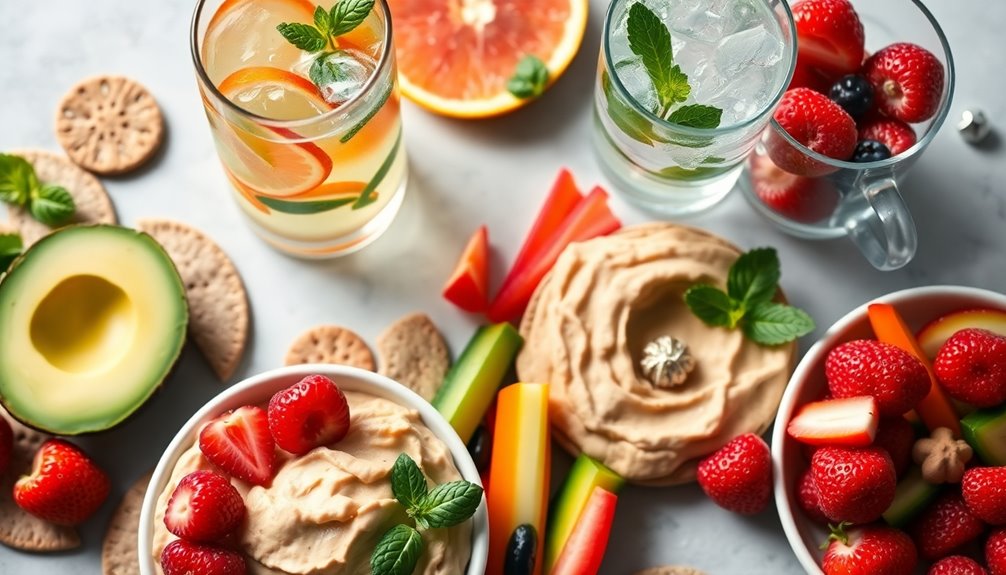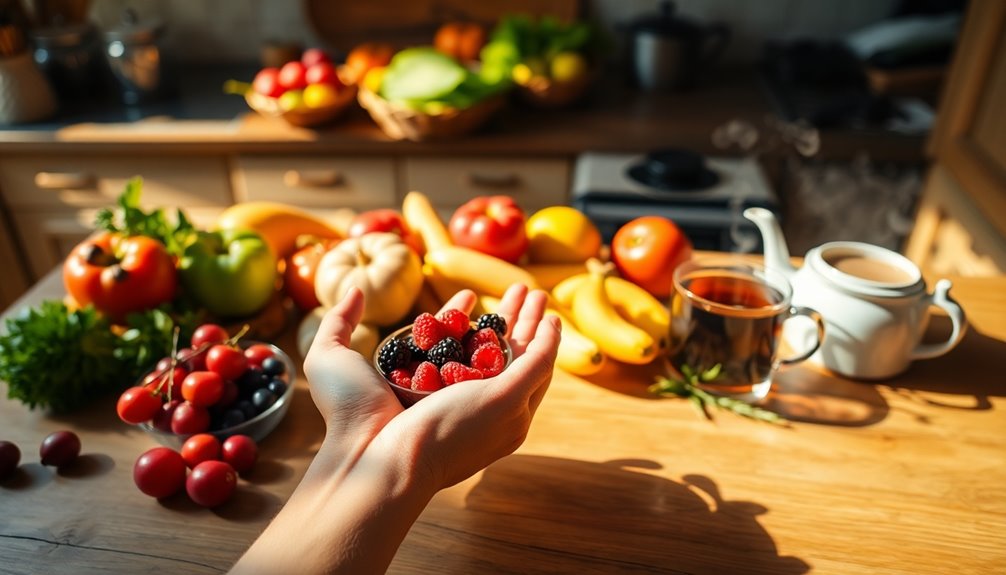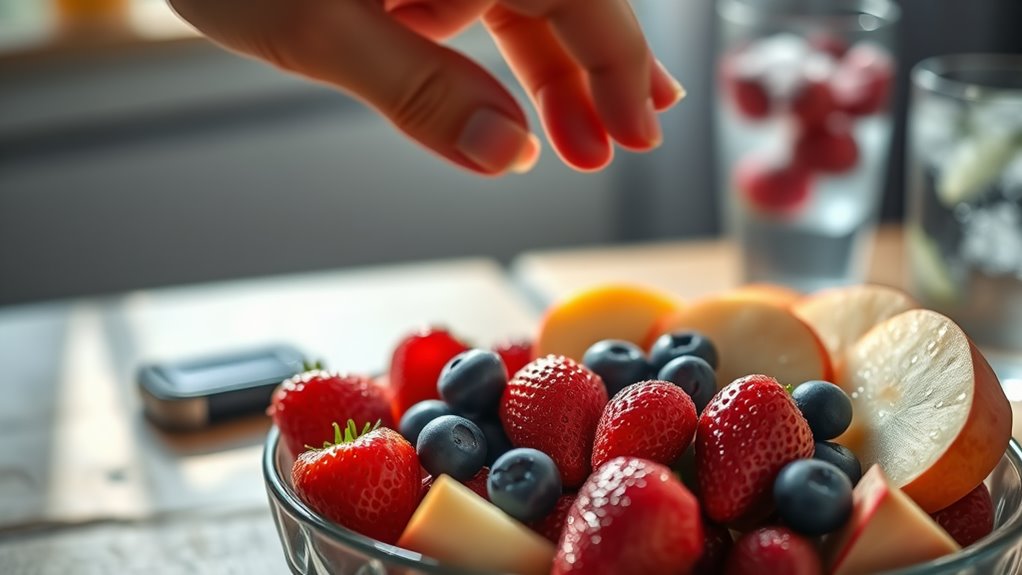To manage cravings without derailing your progress, start by understanding their roots. Identify what triggers your cravings, as emotional eating often plays a role. Explore healthier substitutes like popcorn for chips or Greek yogurt for ice cream. Practicing mindful eating can help you assess your hunger and limit portions effectively. Staying hydrated with plenty of water and incorporating nutrient-dense foods will support your overall wellness. Don't forget to lean on your support system; sharing challenges can make a big difference. There are more strategies to explore that can help you stay on track while enjoying your journey.
Key Takeaways
- Identify and understand your cravings to address their emotional roots effectively.
- Opt for healthier substitutes, such as popcorn or Greek yogurt, to satisfy cravings without guilt.
- Practice mindful eating to enhance your awareness of hunger and portion control.
- Stay hydrated and nourish your body with nutrient-dense foods to curb cravings naturally.
- Build a supportive network to share experiences and strategies for managing cravings.
Understand Your Cravings

Understanding your cravings is essential for managing them effectively. Cravings can often feel overwhelming, but recognizing their roots is the first step toward control. You might notice certain craving triggers—specific situations, emotions, or even people—that lead you to seek comfort in food. By identifying these triggers, you can better prepare yourself for those moments, making it easier to resist unhealthy choices.
Emotional eating is a common response to these triggers. When you're stressed, sad, or even bored, you might find yourself reaching for food as a coping mechanism. It's important to acknowledge that this behavior is normal, but it can lead to a cycle of guilt and further cravings. Instead of succumbing to emotional eating, try to explore healthier ways to handle those feelings. Journaling or talking to a friend can provide an outlet for your emotions without turning to food.
Keep in mind that cravings are a natural part of the human experience. They don't define you, and you're not alone in facing them. Surrounding yourself with supportive individuals who understand your journey can help you navigate these challenges. By learning about your cravings and their triggers, you empower yourself to make informed choices. Remember, it's about progress, not perfection. Every step you take toward understanding your cravings brings you closer to a healthier relationship with food and yourself. Recent research highlights that understanding your body's response to food can aid in reversing Type 2 diabetes naturally, enhancing your overall health and wellbeing.
Healthy Substitutes to Try

Finding healthy substitutes for your cravings can make a significant difference in your journey toward better eating habits. When you're feeling tempted, reaching for flavorful swaps can't only satisfy your taste buds but also keep you on track. Here are three creative snacking ideas to try:
- Popcorn instead of chips: Air-popped popcorn is a whole grain, low-calorie snack that can be seasoned with spices or nutritional yeast for a cheesy flavor. It's crunchy and satisfying, making it a perfect alternative to greasy chips.
- Greek yogurt instead of ice cream: If you're in the mood for something creamy and sweet, opt for Greek yogurt. You can add fresh fruits, a drizzle of honey, or even a sprinkle of dark chocolate to create a deliciously indulgent treat without the excess sugar and fat.
- Nut butter on apple slices instead of candy: Slice up an apple and spread a thin layer of almond or peanut butter on top. This snack isn't only satisfyingly sweet, but it also combines fiber and healthy fats, keeping you fuller for longer. Additionally, incorporating protein-rich vegan smoothies into your diet can help curb cravings while providing essential nutrients.
Mindful Eating Techniques

Mindful eating techniques can transform your relationship with food, making every meal an opportunity for enjoyment and awareness. By engaging fully with your eating experience, you'll find that cravings can be managed more effectively. It starts with practicing mindful snacking. Instead of grabbing snacks mindlessly, take a moment to assess your hunger levels and choose nutritious options that satisfy you. When you're ready to snack, sit down, eliminate distractions, and focus on the flavors and textures of your food. This approach not only enhances your enjoyment but also helps you recognize when you've had enough.
Another essential aspect is mindful portion control. Pay attention to serving sizes and listen to your body's cues. Serving smaller portions can prevent overeating, and you can always go back for more if you're still hungry. Use smaller plates or bowls to help visually control your portions. This simple trick can create a sense of abundance while still keeping your intake in check.
Incorporating these mindful eating techniques into your daily routine cultivates a deeper connection with food. You'll likely find that by being present during meals, you'll crave healthier options and feel more satisfied overall. Additionally, practicing mindfulness can enhance heart rate variability and improve your overall emotional regulation. Remember, it's not just about what you eat; it's about how you eat. By practicing mindfulness, you'll create a balanced relationship with food that supports your health goals while allowing you to enjoy every bite.
Stay Hydrated and Nourished

Staying hydrated and nourished is essential for managing cravings and maintaining overall well-being. When you're well-hydrated and your body is getting the nutrients it needs, you're less likely to turn to emotional eating as a way to cope with uncomfortable feelings. Here are three key strategies to help you stay on track:
- Drink Water Regularly: Aim to drink at least eight glasses of water a day. Sometimes, your body confuses thirst for hunger, leading to unnecessary snacking. Keeping a water bottle handy can help remind you to stay hydrated.
- Incorporate Nutrient-Dense Foods: Focus on whole foods like fruits, vegetables, lean proteins, and whole grains. These foods are packed with vitamins and minerals that help prevent nutrient deficiencies, which can trigger cravings. The more you nourish your body, the better you'll feel. Additionally, following a custom keto diet plan can further enhance your nutritional intake, providing tailored meal options that align with your goals.
- Mind Your Meal Timing: Eating regular meals and snacks can stabilize your blood sugar levels, reducing the likelihood of cravings. Skipping meals often leads to overeating later, which can spiral into unhealthy eating patterns.
Seek Support and Accountability

Building a strong support system can greatly enhance your ability to manage cravings and stick to your goals. When you're faced with those tempting moments, having someone to lean on can make all the difference. Friends, family, or even colleagues can provide encouragement and understanding.
However, consider also tapping into online communities and wellness groups. These platforms connect you with individuals who share similar experiences and aspirations, creating a sense of belonging that can be incredibly motivating.
In wellness groups, you'll find people who genuinely want to see you succeed. Sharing your struggles and victories with others who understand can help you feel less isolated. Research indicates that social support positively impacts behavior change, making it easier to stick to healthier habits. These groups often have regular check-ins, which can enhance your accountability. When you know someone is rooting for you, you're more likely to stay committed.
Online communities offer additional flexibility. You can seek advice or share your challenges anytime, and the anonymity can sometimes make it easier to open up. Participating in discussions or simply reading others' experiences can provide valuable insights and strategies to cope with cravings. Additionally, consider incorporating InnaPeace's brainwave guidance technology to facilitate relaxation and stress release, which can further aid in managing cravings effectively.
Frequently Asked Questions
Can Cravings Indicate a Nutrient Deficiency?
Cravings can indeed indicate a nutrient deficiency. When your body's nutrient balance is off, it often signals a need for specific vitamins or minerals. Conducting a cravings analysis can help you identify patterns; for example, craving chocolate might mean you need magnesium. Understanding these signals allows you to address deficiencies and make more informed food choices, supporting your overall health and well-being.
You're not alone in this journey; many experience similar challenges!
How Do Emotions Impact Food Cravings?
Emotions greatly impact your food cravings. When you're stressed or feeling down, you might turn to emotional eating for comfort. This can lead to cravings for high-calorie foods, which temporarily boost your mood but don't address the underlying issues. Effective stress management techniques, like mindfulness or exercise, can help you cope with emotions without relying on food. Understanding this connection empowers you to make healthier choices and fosters a sense of belonging in your journey.
Are Certain Foods More Likely to Trigger Cravings?
Certain foods act like sirens, luring you into their sugary embrace. High-sugar and high-fat items often trigger cravings, creating distinct craving patterns that pull you off course. It's not just about willpower; your brain craves what it knows. By recognizing these food triggers, you can take charge and make mindful choices.
Surround yourself with supportive folks who understand this journey, and together, you'll navigate the waves of temptation with confidence and resilience.
What Role Does Sleep Play in Cravings?
Sleep quality plays a pivotal role in regulating cravings. When you don't get enough rest, your body struggles with hormone regulation, particularly ghrelin and leptin, which control hunger and satiety.
Poor sleep can increase ghrelin levels, making you feel hungrier, while reducing leptin, which tells you when you're full. Prioritizing good sleep can help you manage cravings more effectively, allowing you to stay on track with your goals and feel more balanced overall.
How Can I Track My Cravings Effectively?
Imagine your cravings as waves in the ocean; they rise and fall. To track them effectively, you can start by journaling your emotions alongside tracking habits. Note when cravings hit, what you were feeling, and any triggers. This practice helps you recognize patterns and understand your cravings better.
Conclusion
In managing cravings, remember that you're not alone in this journey. By understanding your triggers and opting for healthy substitutes, you can maintain your progress. Incorporating mindful eating techniques and staying well-hydrated further supports your goals. So, why not reach out for support when you need it? It can make all the difference. Embrace these strategies, and you'll find that cravings don't have to derail your progress—they can become manageable steps toward a healthier you.



